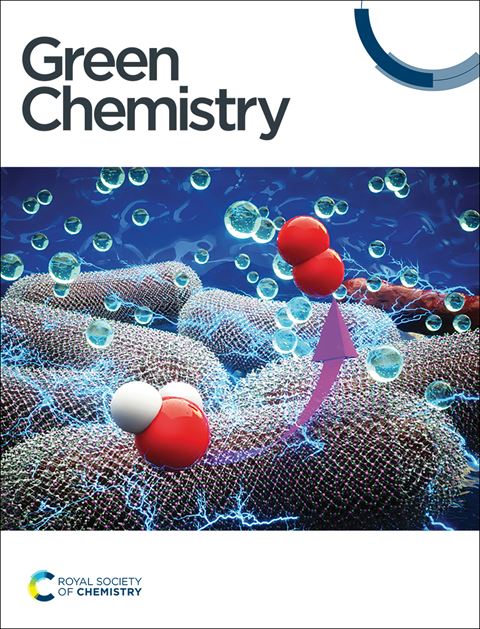蘑菇中几丁质分离技术的比较分析:迈向高纯度生物聚合物的可持续生产
IF 9.3
1区 化学
Q1 CHEMISTRY, MULTIDISCIPLINARY
引用次数: 0
摘要
甲壳素是一种储量丰富、用途广泛的生物聚合物,在生物医药、农业、材料科学等领域有着广泛的应用。传统上从甲壳类动物的废物中提取,它的提取带来了环境和过敏的挑战,推动了替代来源的探索。真菌生物量,特别是来自白蘑菇(Agaricus bisporus)的真菌生物量,提供了一种可再生、低过敏性和非动物替代品,但其复杂的细胞壁结构需要创新的提取技术。采用离子液体1-乙基-3-甲基咪唑醋酸酯([C2mim][OAc])和1-丁基-3-甲基咪唑硫酸氢([C4mim][HSO4]),以及由乳酸和氯化胆碱(LA: [Cho]Cl)组成的深度共晶溶剂,对传统碱性制浆方法进行了比较。结果表明,热[C2mim][OAc]和扩展NaOH法制备的分离物纯度较高(77%),保留了α-几丁质的结构完整性。所生产的纤维显示出与甲壳类提取的甲壳素相当的真菌甲壳素的机械性能,突出了真菌来源的高价值应用的可行性。通过解决真菌甲壳素提取中的关键挑战,这项工作促进了对生态友好方法及其可扩展性的理解。从蘑菇中获取几丁质,而不是从甲壳类动物等传统动物中获取几丁质,这将改变生物质能到碳基产品行业的道德和可持续发展。此外,这些发现强调了真菌生物量在碳高效生物质利用的背景下是一种有价值但未充分利用的资源。蘑菇生长在各种农业和工业废物上,对环境的影响最小,与其他农业和水产养殖过程相比,蘑菇的种植排放的温室气体要少得多。此外,与传统碱法提取真菌甲壳素的方法相比,采用[C2mim][OAc]的提取方法减少了化学废物。将这种类型的甲壳素整合到众多应用中,减少了对传统供应链的依赖,并加强了循环经济方法。本文章由计算机程序翻译,如有差异,请以英文原文为准。

Comparative analysis of chitin isolation techniques from mushrooms: toward sustainable production of high-purity biopolymer†
Chitin, an abundant and versatile biopolymer, is widely used across industries such as biomedicine, agriculture, and materials science. Traditionally sourced from crustacean waste, its extraction poses environmental and allergenic challenges, driving the exploration of alternative sources. Fungal biomass, particularly from white mushrooms (Agaricus bisporus), offers a renewable, hypoallergenic, and non-animal alternative, but its complex cell wall structure demands innovative extraction techniques. This study compares traditional alkaline pulping with environmentally-conscious methods, including ionic liquids 1-ethyl-3-methylimidazolium acetate ([C2mim][OAc]) and 1-butyl-3-methylimidazolium hydrogen sulfate ([C4mim][HSO4]), and a deep eutectic solvent made of lactic acid and choline chloride (LA : [Cho]Cl), for chitin isolation from mushroom biomass. Results indicate that thermal [C2mim][OAc] and extended NaOH pulping produced isolates with superior purity (77%), retaining the structural integrity of α-chitin. The produced fibers demonstrated mechanical properties of fungal chitin comparable to crustacean-extracted chitin, highlighting the viability of fungal sources for high-value applications. By addressing critical challenges in fungal chitin extraction, this work advances the understanding of eco-friendly methods and their potential for scalability. The ability to source chitin from mushrooms rather than from traditional animal-based sources like crustaceans is a game-changer for ethical and sustainable biomass to C-based products industries. In addition, the findings underscore fungal biomass as a valuable yet underutilized resource in the context of carbon-efficient biomass utilization. Mushrooms grow on various agricultural and industrial wastes, have minimal environmental impact, and their cultivation emits significantly fewer greenhouse gases compared to other agri- and aquacultural processes. In addition, the presented extraction method using [C2mim][OAc] reduces chemical waste compared to traditional alkali-based methods for obtaining fungal chitin. Integrating this type of chitin into numerous applications reduces reliance on traditional supply chains and reinforces a circular economy approach.
求助全文
通过发布文献求助,成功后即可免费获取论文全文。
去求助
来源期刊

Green Chemistry
化学-化学综合
CiteScore
16.10
自引率
7.10%
发文量
677
审稿时长
1.4 months
期刊介绍:
Green Chemistry is a journal that provides a unique forum for the publication of innovative research on the development of alternative green and sustainable technologies. The scope of Green Chemistry is based on the definition proposed by Anastas and Warner (Green Chemistry: Theory and Practice, P T Anastas and J C Warner, Oxford University Press, Oxford, 1998), which defines green chemistry as the utilisation of a set of principles that reduces or eliminates the use or generation of hazardous substances in the design, manufacture and application of chemical products. Green Chemistry aims to reduce the environmental impact of the chemical enterprise by developing a technology base that is inherently non-toxic to living things and the environment. The journal welcomes submissions on all aspects of research relating to this endeavor and publishes original and significant cutting-edge research that is likely to be of wide general appeal. For a work to be published, it must present a significant advance in green chemistry, including a comparison with existing methods and a demonstration of advantages over those methods.
 求助内容:
求助内容: 应助结果提醒方式:
应助结果提醒方式:


